Customized seed technology
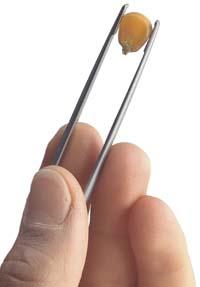
The classic ways to obtain seeds with appropriate characteristics for farmers and consumers are selection and hybridization. Professor Mertxe de Renobales explains that they are long processes, but with them they have obtained most of the current varieties.
Hybridization techniques have made great strides in recent decades and, for example, in vitro culture techniques allow hybridization of species far from each other.
In addition, to increase genetic variability, and thus have more characteristics, they use in laboratories a oriented mutagenesis, which treats seeds with chemicals that cause mutations and radiation, thus obtaining many different mutations. They don't know in which genes mutations have occurred, nor what their effect is, but by sowing seeds and growing plants they see if they are useful. Targeted mutagenesia has allowed more than 1,500 varieties of agricultural use of different types of plants.

For Mertxe de Renobales, genetic transformation has "remarkable advantages". In fact, for the realization of GMOs, the gene related to the desired characteristic is first selected and then introduced into the genome of the seed to be modified. Therefore, the changes that occur in this process are much more controlled than in others and the result is better.
Step by step
Renobales also explains the process of making a transgenic seed. First, they select and isolate the gene they want to enter the plant genome using standard laboratory techniques. Because transformation is not done in a single cell, it is often done, they need many copies of the gene. Copies can be made with a synthesizer, but it is easier to use bacteria to synthesize them.
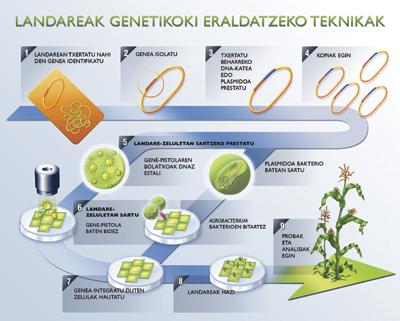
It is necessary to integrate the gene into a plasmid. Plasmids are small rings of DNA that are normally found in bacteria and replicate spontaneously, separated from the DNA of chromosomes. In this case the plasmid must be prepared to work in the plant cell.
According to De Renobales, "genes are like prescription cassettes and in order for it to process plant cells it is necessary to give them the appropriate orders". In this way, they add to the gene an appropriate initiating sequence for the plant and the one that gives order to finish, and sometimes alter the gene's own sequence.
Finally, the plasmid, properly conditioned, is introduced into the bacteria so that copies are synthesized during reproduction. The next step is taking plasmids and their introduction into plant cells, for which there are several forms. The most common are the bacteria Agrobacterium and the gene gun.
Integration into the plant cell
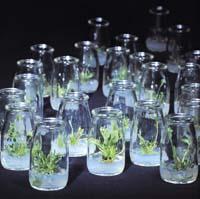
Agrobacterium tumefaciens and other species of the same genus inhabit the soil, naturally introducing DNA into plant cells. In addition, they can make copies of the plasmids, so they are the appropriate means to introduce the desired DNA sequence in plant cells.
To do this, researchers use: they place fragments of plant leaves on a plate, and the bacteria penetrate through the wounds and insert the plasma into the plant cell. And plasmid is integrated into the plant cell genome. This method is used in approximately 350 species, most dicotyledonous.
Other plants, cereals and other monocotyledons use the gene gun. These pistols release gold or tungsten balls coated with DNA against plant cells. Most of these balls cross the cells, but few remain within the plant cells. And sometimes the cells integrate the DNA around the ball into their genome. According to De Renobales, "the process is not very effective": only 10% of the treated cells incorporate DNA.
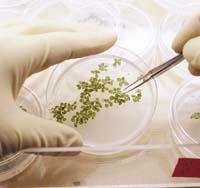
Both methods allow the cultivation of plant cells using in vitro techniques. "There are no particularities in this," says Renobales. That is, as on other occasions, plants need to grow to see the effect of the established treatment. Of course, they sometimes use marker genes to know which cells the gene they wanted to insert has been introduced into.
Sometimes, some of these markers are antibiotic-resistant genes. In this way, the cells are treated with antibiotics, and those that survive are the marker genes and, therefore, those that have another. According to De Renobales, these marker genes have generated a "debate", since being integrated into the cell, some feared that antibiotic resistance would be transmitted. However, only some marker genes are authorized and their resistance is not resistance to antibiotics used in humans and animals. Now it is also possible to remove these markers.
However, plant cells grow plants and see their characteristics. Depending on this, they select useful plants. They perform precise molecular and chemical characterizations of the selected ones, as well as safety studies and agronomic value. Subsequently, field tests are carried out and, if all of them are exceeded, marketing authorization is requested.
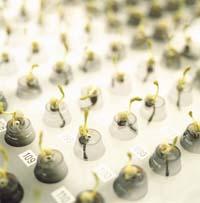
According to De Renobales, "maybe you started the process with 10-20 thousand cells and you end up getting a single plant with the characteristics you wanted." In addition, this process lasts for years, although it is faster than other methods. Otherwise, De Renobales has no doubt: biotechnology can bring many benefits: for people with health problems, suitable varieties can be made, capable of growing in arid lands, which serve to clean contaminated soils... And there are researchers who are doing it.
Buletina
Bidali zure helbide elektronikoa eta jaso asteroko buletina zure sarrera-ontzian











